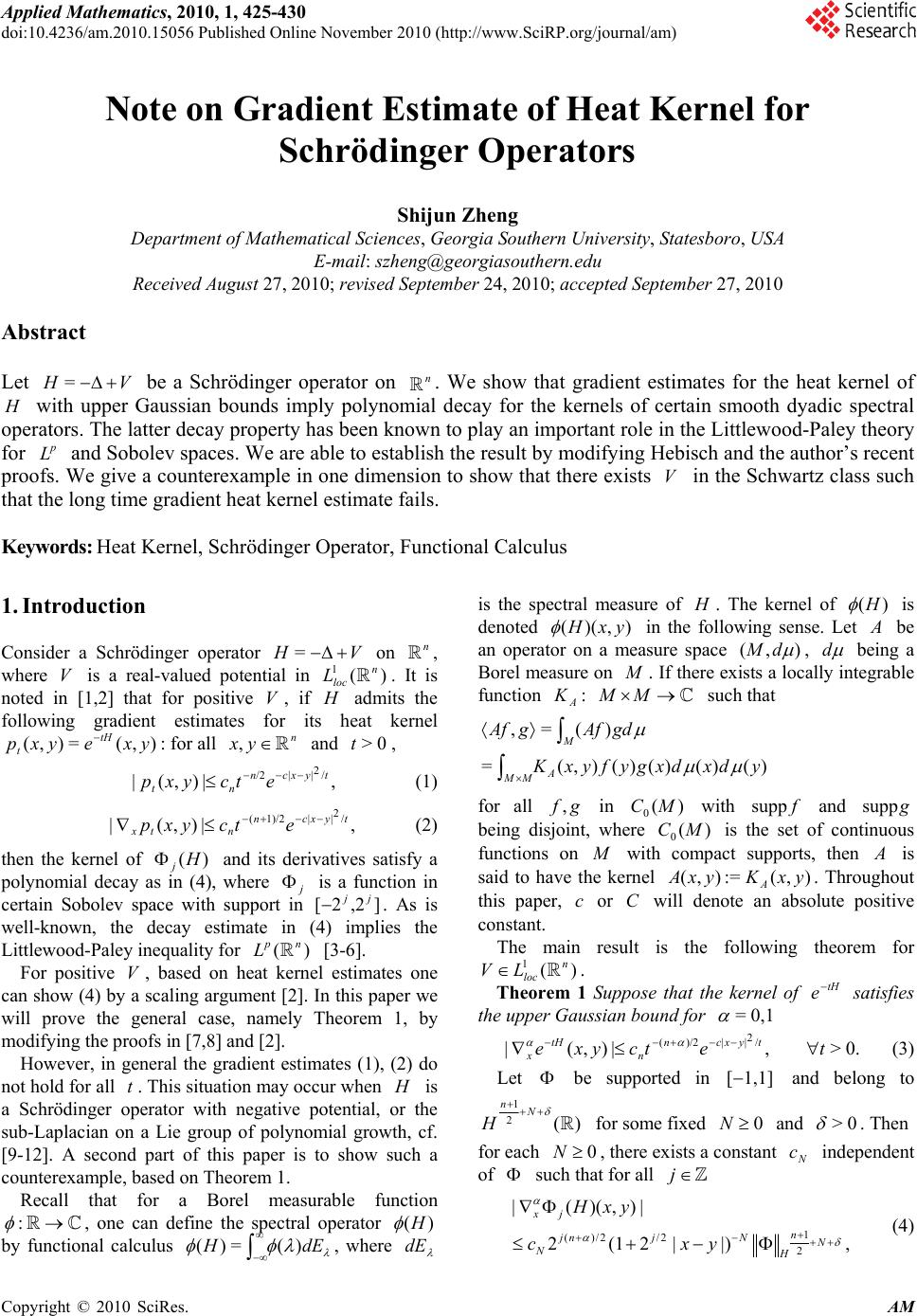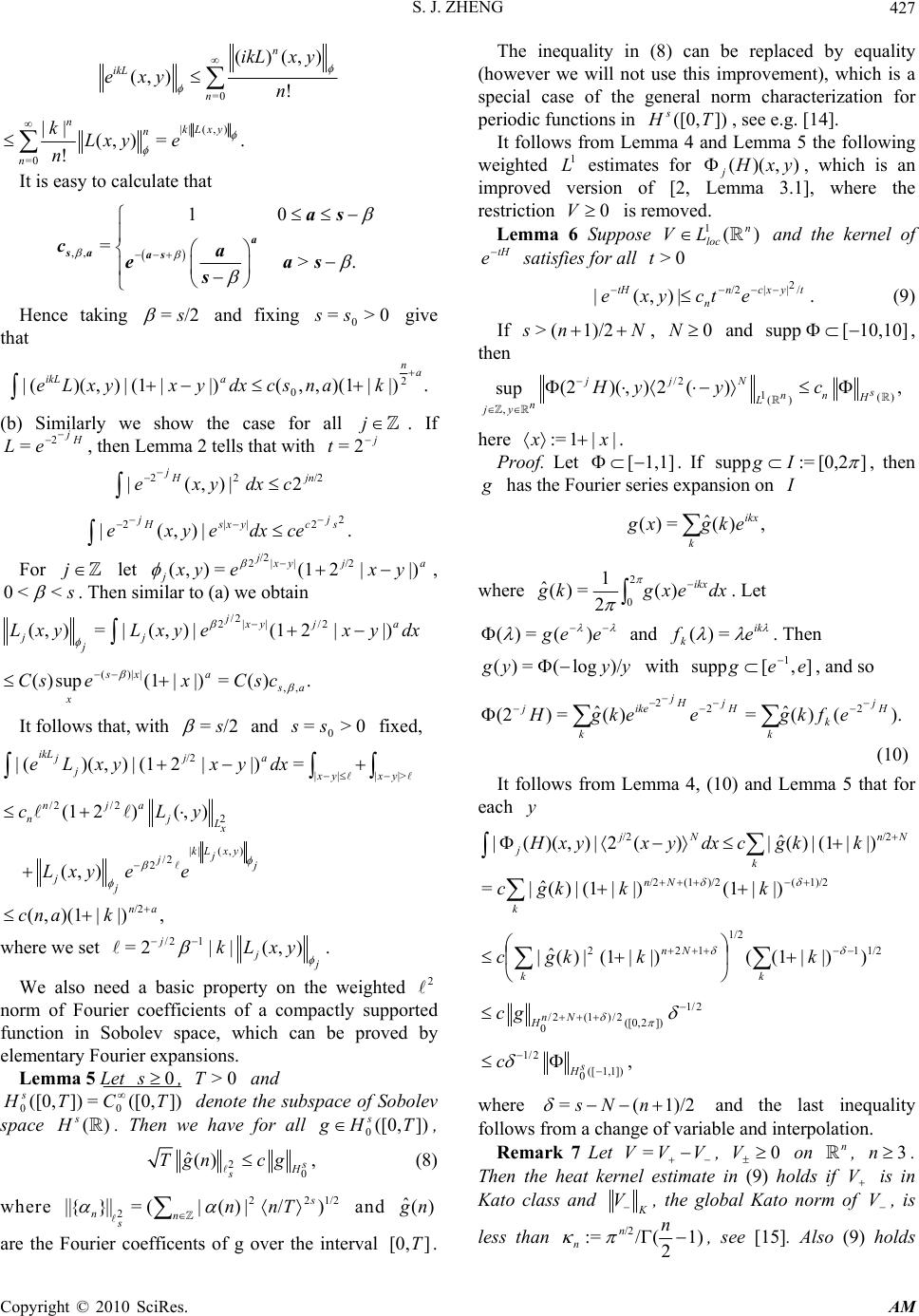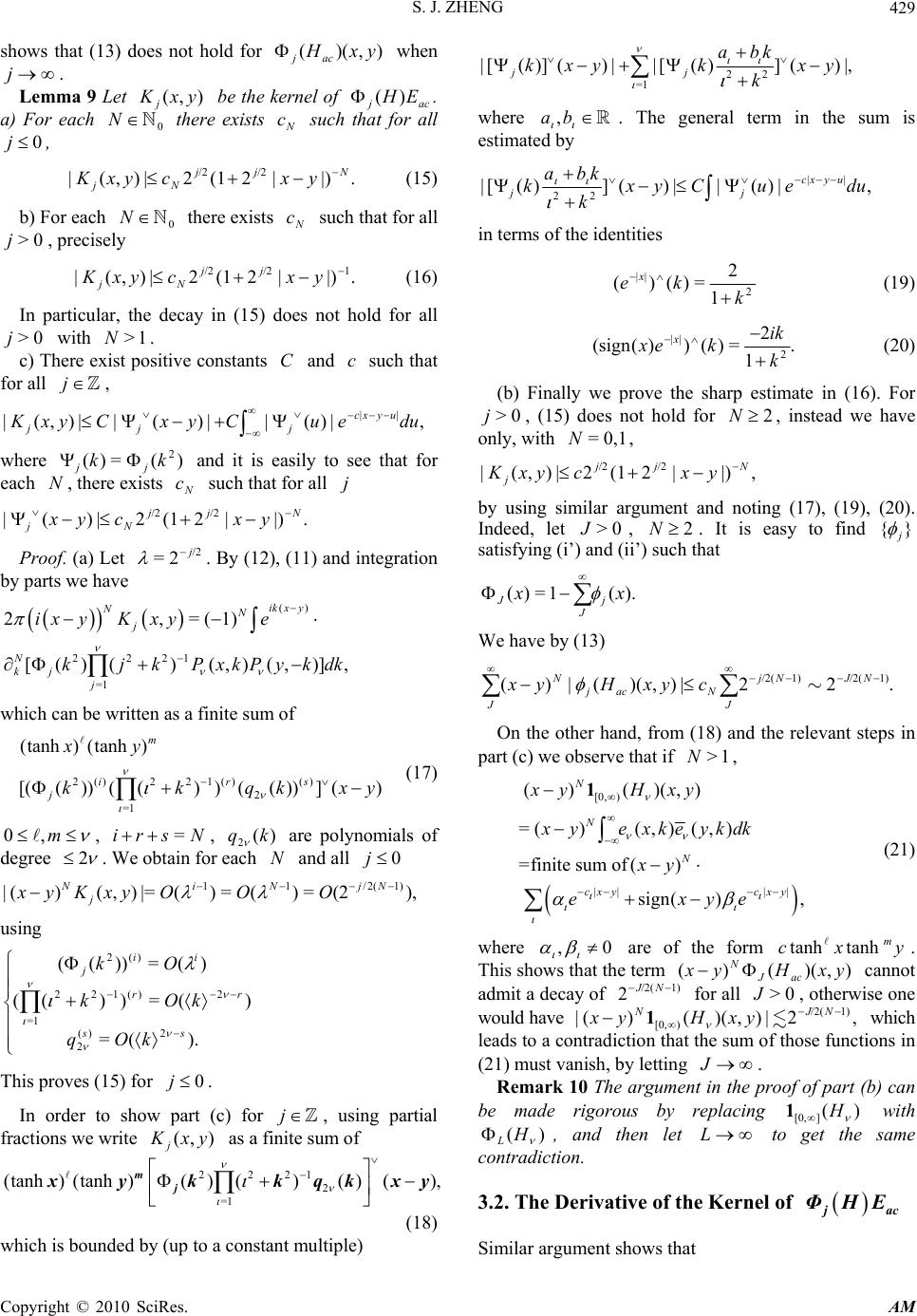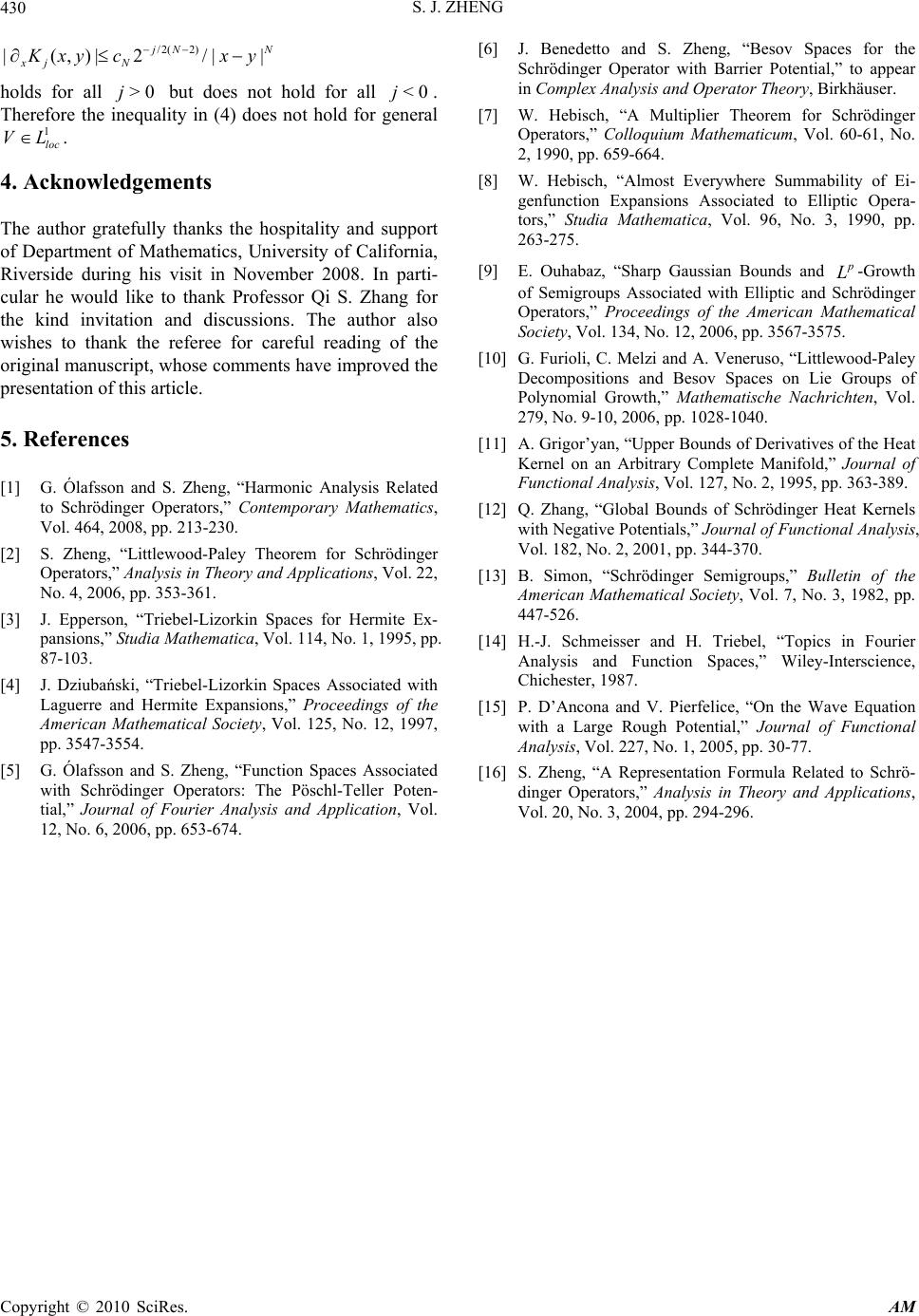Paper Menu >>
Journal Menu >>
 Applied Mathematics, 2010, 1, 425-430 doi:10.4236/am.2010.15056 Published Online November 2010 (http://www.SciRP.org/journal/am) Copyright © 2010 SciRes. AM Note on Gradient Estimate of Heat Kernel for Schrödinger Operators Shijun Zheng Department of Mathematical Sciences, Georgia Southern University, Statesboro, USA E-mail: szheng@georgiasouthern.edu Received August 27, 2010; revised September 24, 2010; accepted September 27, 2010 Abstract Let = H V be a Schrödinger operator on n . We show that gradient estimates for the heat kernel of H with upper Gaussian bounds imply polynomial decay for the kernels of certain smooth dyadic spectral operators. The latter decay property has been known to play an important role in the Littlewood-Paley theory for p L and Sobolev spaces. We are able to establish the result by modifying Hebisch and the author’s recent proofs. We give a counterexample in one dimension to show that there exists V in the Schwartz class such that the long time gradient heat kernel estimate fails. Keywords: Heat Kernel, Schrödinger Operator, Functional Calculus 1. Introduction Consider a Schrödinger operator = H V on n , where V is a real-valued potential in )( 1n loc L. It is noted in [1,2] that for positive V, if H admits the following gradient estimates for its heat kernel ),(=),(yxeyxp tH t : for all n yx , and 0>t, ,|),(| / 2 ||/2 tyxcn nt etcyxp (1) ,|),(| / 2 ||1)/2( tyxcn ntxetcyxp (2) then the kernel of )(H j and its derivatives satisfy a polynomial decay as in (4), where j is a function in certain Sobolev space with support in ],22[ jj . As is well-known, the decay estimate in (4) implies the Littlewood-Paley inequality for )( np L [3-6]. For positive V, based on heat kernel estimates one can show (4) by a scaling argument [2]. In this paper we will prove the general case, namely Theorem 1, by modifying the proofs in [7,8] and [2]. However, in general the gradient estimates (1), (2) do not hold for all t . This situation may occur when H is a Schrödinger operator with negative potential, or the sub-Laplacian on a Lie group of polynomial growth, cf. [9-12]. A second part of this paper is to show such a counterexample, based on Theorem 1. Recall that for a Borel measurable function : , one can define the spectral operator )(H by functional calculus ()= () H dE , where dE is the spectral measure of H . The kernel of )(H is denoted ),)(( yxH in the following sense. Let A be an operator on a measure space ),( dM , d being a Borel measure on M . If there exists a locally integrable function A K: MM such that ,=() =(, ) ()()()() M A MM Af gAf gd K xy fygxdxdy for all gf , in )( 0MC with fsupp and g supp being disjoint, where )( 0MC is the set of continuous functions on M with compact supports, then A is said to have the kernel ),(:=),( yxKyxA A. Throughout this paper, c or C will denote an absolute positive constant. The main result is the following theorem for )( 1n loc LV . Theorem 1 Suppose that the kernel of tH e satisfies the upper Gaussian bound for 0,1= 0.>,|),(| / 2 ||)/2(tetcyxe tyxcn n tH x (3) Let be supported in 1,1][ and belong to )( 2 1 N n H for some fixed 0N and 0> . Then for each 0N, there exists a constant N c independent of such that for all j 1 ( )/2/2 2 |()(,)| 2(12||) , xj n jnjN N NH Hxy cxy (4)  S. J. ZHENG Copyright © 2010 SciRes. AM 426 where )(2=)( xx j j and )(:= ss HH denotes the usual Sobolev space with norm 22/2 2 =(1/ ) s s H L f ddx f. When V is positive, a result of the above type was proved and applied to the cases for the Hermite and Laguerre operators [1]. The observation was that if 0V, then the constants corresponding to Lemma 2 do not change for VH = with )(=)( 2xVxV (called scaling-invariance in what follows), according to the Feynman-Kac path integral formula [13] (()) 0 ()=(()) , t Vsds tH x efx Efte here x E is the integral over the path space with respect to the Wiener measure x , n x and )(t stands for a brownian motion (generic path). For general V the technical difficulty is that we do not have such a scaling-invariance. We are able to overcome this difficulty by establishing Lemma 6, a scaling version of the weighted 1 L inequality for ),)(( yxH j with s H , for which we directly use the scaling information indicated by the time variable appearing in Lemma 2. Thus this leads to the proof of the main theorem by combining methods of Hebisch and the author’s in [7,2]. In Section 3 we give a counterexample to show that for 2 )cosh1)((=)( xxV , , the estimates in (1) and (2) fail for t . Note that under the condition in Theorem 1, (4) is valid for all )( 0 C j , j satisfying (i) }2|:|{supp j jxx and (ii) ,2|)(| )( kj k k jcx 0=0k . A corollary is that (3) implies the Littlewood-Paley inequality 21/2 () () (|()()|),1<< pnj Lpn jL fHf p (5) for both homogeneous and inhomogeneous systems j , according to [1, Theorem 1.5], see also [2,3]. 2. Heat Kernel Having Upper Gaussian Bound Implies Rapid Decay for Spectral Kernels In this section we prove Theorem 1. Following [7] we begin with a simple lemma. Lemma 2 Suppose that (1) holds. Then 2/2 |(,)| =:() tH n exydxct Ct ).,(=:|),(| 2 ||tsCcedxeyxe tcsyxstH The next lemma can be easily proved by a duality argument and we omit the details. Lemma 3 Let L be a selfadjoint operator on )( 2n L and )(, L . Then for each y, 22 22 ()()(,)() ()(,). L L LyLLy If in addition )( L is unitary, then the equality holds. Let w be a submultiplicative weight on nn , i.e., ),(),(),(0 yzwzxwyxw , n zyx ,, . For simplicity we also assume ),(=),(xywyxw. Define the norm for )( 21n loc Lk as follows: (, )=|(, )|(,). sup n wn y kxykxy wxydx Then given two operators 21,LL , it holds that 121 2 ()(,)(,)(,). www LLxyL xyLxy (6) The following lemma is a scaling version of [8, Theorem 3.1] for )( 1n loc LV . Lemma 4 Suppose that (1) holds. Let H j jeL 2 =. Then for each 0a, there exists a constant ),(= ancc depending on an, only such that for all j and k, /2 /2 |()(,)|(12||) ( ,)(1||). ikL ja j j na eLxyxydx cnak (7) Proof. (a) First we show the case 0=j. For nota- tional convenience write 0 =LL , then by Lemma 2 we have, with 1=t, 2 (, )(1)= sup Lx y LxyCc .=)(=:,1)(|),(| sup 2 ||csyxs y cesCsCdxeyxL Let ayx yxeyx |)|(1=),( || , s<<0 . Then dxyxeeyxLyxL ayxsyxs |)|(1|),(|=),( ||)(|| .)(=:|)|(1 sup )( ,, ||)( ,as ayxs yx csCyxesC In view of Lemma 3, setting 1 =||(,)kLxy , we have |>||| =|)|(1|),)((| yxyx aikLdxyxyxLe || (,) /2 2 (1)(, )(, )kLxy na Lx LyLxye e 12 ,, ,, (1)(1||())(), na s asa CkCscCsc where we note that by (6)  S. J. ZHENG Copyright © 2010 SciRes. AM 427 =0 ()(,) (, )! n ikL n ikLx y exy n ||(, ) =0 || (,)=. ! nkLxy n n kLxy e n It is easy to calculate that ,, 10 =>. a sa as as ca eas s Hence taking /2= s and fixing 0>= 0 ss give that .|)|)(1,,(|)|(1|),)((|2 0 a n aikLkanscdxyxyxLe (b) Similarly we show the case for all j. If H j eL 2 =, then Lemma 2 tells that with j t 2= /222 2|),(|jnH jcdxyxe .|),(|2 2||2 s j cyxsH jcedxeyxe For j let ajyx j jyxeyx |)|2(1=),( /2|| /2 2 , s<<0 . Then similar to (a) we obtain /2 2| |/2 (, )=|(, )|(12||) jxy ja jj j LxyLxy exydx .)(=|)|(1 sup )( ,, ||)( as axs x csCxesC It follows that, with /2= s and 0>= 0 ss fixed, |>||| /2 =|)|2(1|),)((| yxyx aj j j ikL dxyxyxLe /2 /2 2 || (,) /2 2 (12)(,) (,) nja nj Lx kL xy j j j jj cLy Lxy ee ,|)|)(1,( /2 an kanc where we set /2 1 =2||( ,) j j j kLxy . We also need a basic property on the weighted 2 norm of Fourier coefficients of a compactly supported function in Sobolev space, which can be proved by elementary Fourier expansions. Lemma 5 Let 0s, 0>T and ])([0,=])([0,00 TCTH s denote the subspace of Sobolev space )( s H. Then we have for all ])([0, 0THg s , 20 ˆ() , s H s Tgn cg (8) where 1/222 2)/|)(|(=}{ s n s nTnn and )( ˆng are the Fourier coefficents of g over the interval ][0,T. The inequality in (8) can be replaced by equality (however we will not use this improvement), which is a special case of the general norm characterization for periodic functions in ])([0,TH s, see e.g. [14]. It follows from Lemma 4 and Lemma 5 the following weighted 1 L estimates for ),)(( yxH j , which is an improved version of [2, Lemma 3.1], where the restriction 0V is removed. Lemma 6 Suppose )( 1n loc LV and the kernel of tH e satisfies for all 0>t .|),(| / 2 ||/2 tyxcn n tH etcyxe (9) If Nns 1)/2(> , 0N and 10,10][supp , then /2 1() () , (2)( ,)2(), sup jjN s n nH L n jy Hy yc here ||1:=xx . Proof. Let 1,1][ . If ][0,2:=supp Ig , then g has the Fourier series expansion on I ,)( ˆ =)( ikx k ekgxg where dxexgkg ikx )( 2 1 =)( ˆ2 0 . Let eeg )(=)( and ik kef =)( . Then yyyg )/log(=)( with ],[supp 1eeg , and so ).()( ˆ =)( ˆ =)(2 22 2H j k k H j H j ike k jefkgeekgH (10) It follows from Lemma 4, (10) and Lemma 5 that for each y Nn k Nj jkkgcdxyxyxH /2/2 |)|(1|)( ˆ |)(2|),)((| 1)/2()/2(1/2 |)|(1|)|(1|)( ˆ |= kkkgc Nn k 1/21 1/2 122)|)|(1(|)|(1|)( ˆ | kkkgc k Nn k 1/2 /2(1 )/2([0,2]) 0 nN H cg 1/2 ([ 1,1]) 0, s H c where 1)/2(= nNs and the last inequality follows from a change of variable and interpolation. Remark 7 Let VVV =, 0 V on n , 3n. Then the heat kernel estimate in (9) holds if V is in Kato class and K V, the global Kato norm of V, is less than 1) 2 (/:= /2 n n n , see [15]. Also (9) holds  S. J. ZHENG Copyright © 2010 SciRes. AM 428 whenever 0V is locally integrable on n , 1n. 2.1. Proof of Theorem 1 With (3) and Lemma 6 we are in a position to prove (4). The proof is similar to that of Proposition 3.3 in [2] in the case of positive V. For completeness, we present the details here. .),))(()(,(=),)(( dzyzHezxeyxH j tHtH x z jx By (3) we have |),)((| yxH jx 2 ()/2 ||/ ()/()/ ()/ ncxzt NN n N ctex ztx zt zy t dzyzHetyz j tHN|),))(((|)/( ()/2 ()/ ()/ |((2))(,)|. nNN n tH j ctxy tzy t eHzydz Applying Lemma 6 with j t 2=, we obtain |),)((| yxH jx /2 1 2 /N nnN nH ctx yte 1 /2 2 ()/ ,>0. n nNN nH ctx yt Remark 8 In the following section we will show that there exists V, the Schwartz class, such that (4) does not hold for j. By Theorem 1, this means that for such V the gradient upper Gaussian bound (3) does not hold for all t . 3. A Counterexample to the Gradient Heat Kernel Estimate Consider the solvable model VdxdH 22 /= , , where .sech1)(=)( 2xxV We know from [5] that solving the Helmholtz equation for {0}\k ),,(=),( 2kxekkxeH yields the following formula for the continuum eigen- functions: ,),( || 1 ))(sign(=),( 1= ikx j ekxP kij kkxe where ),tanh(=),( ikxpkxP is defined by the recursion formula 11 (tanh ,) =((tanh ,))(tanh)(tanh ,), pxik dpx ikikxpx ik dx with 1 0 p. Note that ),(=),( kxekxe and the function () 22 =1 (, ,)(,)(,) 1 =(,)(,) ik xy j xyk exkeyk PxkPy ke jk (11) is real analytic on 3 . Moreover, H has only absolutely continuous spectrum )[0,= ac and point spectrum .},4,1,{=2 pp The corresponding eigenfunctions 1= }{ nn e in 2 L are Schwartz functions that are linear combinations of xx mtanh sech , m, 0 . Let acac EHH = denote the absolutely continuous part of H and )[0, = EEac the corresponding orthogonal projection. If )( 0C , then we have for all 21 LLf , ,),)(()(),(=)()( 2 1= nn n eefndyyfyxKxfH where dxxexfef nn)()(=),( and dkkyekxekyxK ),(),()()(2=),( 21 (12) is the kernel of acacEHH )(=)( , cf. [16]. Since H has eigenfunctions in )( and pp is finite, from now on it is essential to check the kernel ),(=),)(( yxKyxHac instead of the kernel of )( H. 3.1. Decay for the Kernel of acjEH )( Let )(}{ 0= C jj satisfy }2||2:{supp)i( 2jj jxx and jcx kj k k j,2|)(|)i(i )( , 0 k. Let ),)((=),( yxHyx acjj . In [5] we showed that for each N ,,|)|2(12|),(| /2/2 jyxcyx Njj Nj (13) but (with 1= ) Njj Njxyxcyx |)|2(12|),(| /2|)|/2(1 (14) only holds for 0j and does not hold for all 0<j. This suggests that (3) fails for 1= and 1>t (or more precisely t ), according to Theorem 1. Now consider the system jj}{ which satisfy (i), (ii) as in Section 1. We may assume )(2=)( xx j j for a fixed in 1,1])([ C with 1=)(x on ] 2 1 , 2 1 [. Let f and f be the Fourier transform and its inverse of f on . The following lemma  S. J. ZHENG Copyright © 2010 SciRes. AM 429 shows that (13) does not hold for ),)(( yxHacj when j. Lemma 9 Let ),( yxK j be the kernel of acj EH)(. a) For each 0 N there exists N c such that for all 0j, .|)|2(12|),(| /2/2 Njj Nj yxcyxK (15) b) For each 0 N there exists N c such that for all 0>j, precisely .|)|2(12|),(| 1/2/2 yxcyxK jj Nj (16) In particular, the decay in (15) does not hold for all 0>j with 1>N. c) There exist positive constants C and c such that for all j, ,|)(||)(||),(| || dueuCyxCyxK uyxc jjj where )(=)( 2 kkjj and it is easily to see that for each N, there exists N c such that for all j .|)|2(12|)(| /2/2 Njj Nj yxcyx Proof. (a) Let /2 2=j . By (12), (11) and integration by parts we have () 2221 =1 2,=(1) [()() (,)(,)], ik xy NN j N kj j ix yKxye kjkPxkPykdk which can be written as a finite sum of 2()221()() 2 =1 (tanh) (tanh) [(())(())(())] () m irs j xy kkqkxy (17) m,0 , Nsri = , )( 2kq are polynomials of degree 2. We obtain for each N and all 0 j 11/2(1) |()(,)|=() =()=(2), NiNjN j xyKxyOOO using ).(= )(=))(( )(=))(( 2)( 2 2)(122 1= )(2 ss rr ii j kOq kOk Ok This proves (15) for 0j. In order to show part (c) for j, using partial fractions we write ),( yxK j as a finite sum of 2221 2 =1 (tanh) (tanh)()()()(), m j xyk kqkxy (18) which is bounded by (up to a constant multiple) 22 =1 |[()]( )||[()]()|, jj abk kxyk xy k where ba,. The general term in the sum is estimated by ,|)(||)(])([| || 22 dueuCyx k kba kuyxc jj in terms of the identities 2 || 1 2 =)()( k ke x (19) . 1 2 =)())(sign( 2 || k ik kex x (20) (b) Finally we prove the sharp estimate in (16). For 0>j, (15) does not hold for 2N, instead we have only, with 0,1=N, ,|)|2(12|),(| /2/2Njj jyxcyxK by using similar argument and noting (17), (19), (20). Indeed, let 0>J, 2N. It is easy to find }{ j satisfying (i’) and (ii’) such that ).(1=)( xxj J J We have by (13) .22|),)((|)( 1)/2(1)/2( NJNj J Nacj N J cyxHyx On the other hand, from (18) and the relevant steps in part (c) we observe that if 1>N, [0, ) || || () ()(,) =()(, )(, ) =finite sum of() sign( ), N N N cx ycx y xyH xy xy exkeykdk xy exye 1 (21) where 0, are of the form tanhtanh m cx y . This shows that the term ),)(()( yxHyxacJ N cannot admit a decay of 1)/2( 2 NJ for all 0>J, otherwise one would have ,2|),)(()(| 1)/2( )[0, NJN yxHyx 1 which leads to a contradiction that the sum of those functions in (21) must vanish, by letting J. Remark 10 The argument in the proof of part (b) can be made rigorous by replacing )( ][0, H 1 with )( H L , and then let L to get the same contradiction. 3.2. The Derivative of the Kernel of j ac ΦHE Similar argument shows that  S. J. ZHENG Copyright © 2010 SciRes. AM 430 /2(2) |(,)|2 /|| j NN xj N K xycx y holds for all 0>j but does not hold for all 0<j. Therefore the inequality in (4) does not hold for general 1 loc VL. 4. Acknowledgements The author gratefully thanks the hospitality and support of Department of Mathematics, University of California, Riverside during his visit in November 2008. In parti- cular he would like to thank Professor Qi S. Zhang for the kind invitation and discussions. The author also wishes to thank the referee for careful reading of the original manuscript, whose comments have improved the presentation of this article. 5. References [1] G. Ólafsson and S. Zheng, “Harmonic Analysis Related to Schrödinger Operators,” Contemporary Mathematics, Vol. 464, 2008, pp. 213-230. [2] S. Zheng, “Littlewood-Paley Theorem for Schrödinger Operators,” Analysis in Theory and Applications, Vol. 22, No. 4, 2006, pp. 353-361. [3] J. Epperson, “Triebel-Lizorkin Spaces for Hermite Ex- pansions,” Studia Mathematica, Vol. 114, No. 1, 1995, pp. 87-103. [4] J. Dziubański, “Triebel-Lizorkin Spaces Associated with Laguerre and Hermite Expansions,” Proceedings of the American Mathematical Society, Vol. 125, No. 12, 1997, pp. 3547-3554. [5] G. Ólafsson and S. Zheng, “Function Spaces Associated with Schrödinger Operators: The Pöschl-Teller Poten- tial,” Journal of Fourier Analysis and Application, Vol. 12, No. 6, 2006, pp. 653-674. [6] J. Benedetto and S. Zheng, “Besov Spaces for the Schrödinger Operator with Barrier Potential,” to appear in Complex Analysis and Operator Theory, Birkhäuser. [7] W. Hebisch, “A Multiplier Theorem for Schrödinger Operators,” Colloquium Mathematicum, Vol. 60-61, No. 2, 1990, pp. 659-664. [8] W. Hebisch, “Almost Everywhere Summability of Ei- genfunction Expansions Associated to Elliptic Opera- tors,” Studia Mathematica, Vol. 96, No. 3, 1990, pp. 263-275. [9] E. Ouhabaz, “Sharp Gaussian Bounds and p L-Growth of Semigroups Associated with Elliptic and Schrödinger Operators,” Proceedings of the American Mathematical Society, Vol. 134, No. 12, 2006, pp. 3567-3575. [10] G. Furioli, C. Melzi and A. Veneruso, “Littlewood-Paley Decompositions and Besov Spaces on Lie Groups of Polynomial Growth,” Mathematische Nachrichten, Vol. 279, No. 9-10, 2006, pp. 1028-1040. [11] A. Grigor’yan, “Upper Bounds of Derivatives of the Heat Kernel on an Arbitrary Complete Manifold,” Journal of Functional Analysis, Vol. 127, No. 2, 1995, pp. 363-389. [12] Q. Zhang, “Global Bounds of Schrödinger Heat Kernels with Negative Potentials,” Journal of Functional Analysis, Vol. 182, No. 2, 2001, pp. 344-370. [13] B. Simon, “Schrödinger Semigroups,” Bulletin of the American Mathematical Society, Vol. 7, No. 3, 1982, pp. 447-526. [14] H.-J. Schmeisser and H. Triebel, “Topics in Fourier Analysis and Function Spaces,” Wiley-Interscience, Chichester, 1987. [15] P. D’Ancona and V. Pierfelice, “On the Wave Equation with a Large Rough Potential,” Journal of Functional Analysis, Vol. 227, No. 1, 2005, pp. 30-77. [16] S. Zheng, “A Representation Formula Related to Schrö- dinger Operators,” Analysis in Theory and Applications, Vol. 20, No. 3, 2004, pp. 294-296. |

